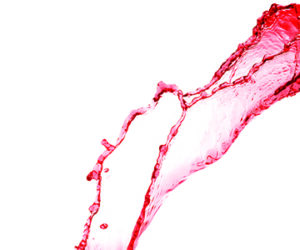Pectic enzymes can be a significant help to maximize yields, increase color and flavor extraction, and make filtration easier by breaking down pectin. These benefits are especially useful in making wines from fruits higher in pectin. Three pros share advice on when and why they turn to these enzymes to help in the winery.

Brian Hosmer is the Winemaker at Chateau Chantal and Hawthorne Vineyards in Traverse City, Michigan
Pectic enzymes have several uses in winemaking. Typically, they are utilized to break something down into smaller parts and/or extract a desired compound. There are multiple formulations for different applications, so the appropriate product should be chosen based on the use. They can be used for settling of juice to increase yields at pressing or racking by breaking down the pectins so they compact, allowing the juice to be more easily separated from the pulp. They can also be used before pressing white grapes or during red fermentation to extract color and/or flavors by breaking the bond to things like polysaccharides. They can also be used to break down pectin or other filter plugging compounds so filtration can go smoother.
Care should be used in selecting the appropriate enzyme for the application as some enzymes are too aggressive to use on whole fruit and will turn the whole batch into mush that will be impossible to press or separate from the solids.
Wine made from fruit other than grapes is one of the best places to use pectic enzymes. Many fruits have more pectin in them than vinifera grapes, though hybrids tend to have more pectin than other wine grapes. That said, underripe grape varieties of all types tend to be higher in pectin as well. In the instance of fruits other than grapes, wine filtration can be near impossible without the use of enzymes in the worst cases, and even in the best cases you will get more wine through a set of filter pads with their use.
Enzymes should be added based on the recommendations of the manufacturer and application. That said, there are some things to be aware of when adding pectic enzymes. The first is temperature: The colder the wine or juice, the slower they will work.
Second is inhibitors: Additives such as sulfur, bentonite, and tannins can inhibit or inactivate enzymatic activity. All these things should be added separately and fully homogenized prior to the next one. Sulfur will inhibit at high rates so it will need to be mixed well first so that it is equally distributed without any pockets of high concentration as it can settle to the bottom. Bentonite will inhibit enzymes completely so you should remove the wine from bentonite prior to adding, or conversely it could be added once the desired effect has occurred to stop enzymatic activity.
Pectic enzymes as a method of clarification are not going to be as clearly obvious as traditional fining agents in that they don’t operate in the same way, so I don’t typically classify them as a fining agent. They don’t bind to anything in particular and precipitate it out, but rather break it down into smaller compounds that remain in solution.
There are times when pectic enzymes may be too effective, like if you’re doing a cold soak on white grapes before pressing. They may accelerate extraction faster than you might be used to and the wine could end up with extra astringency. But the bigger concern is misusing a very aggressive formulation before pressing and being unable to get clean pressing and separation.
As a whole, pectic enzymes can be a very effective tool depending on the desired use. Make sure that you understand what it is formulated for and what conditions it requires for efficient use.

José Real is the Winemaker at Boordy Vineyards in Hydes, Maryland
Pectinase is an enzyme that breaks the structural bonds that keep the tissue of grapes from being attacked by fungus or any other microbial threat. Once broken, the internal structure is exposed, which facilitates the extraction of juice (aka free run) and any material from the skin like polysaccharides, proteins, aroma precursors, etc.
I recommend using pectic enzymes to obtain a good yield from your grapes. Another good reason is because there is a lot of varietal character embedded in the pulp and epithelial tissue that can be extracted as well. I highly advise it for white and rosé winemaking. It will create cleaner wines with more aroma and finesse.
Since it helps with the free run of juice, I think its use is important regardless of the grape variety, so I’d recommend it for all uses and styles for economic reasons. However, the higher the varietal character of the grape, the more important its use. For example, you will need to use a more concentrated and complex cocktail of enzymes, where pectinase is one of them, for Albariño than for Pinot Gris, since Albariño has a richer and deeper varietal character. Pectinase also acts synergically with other enzymes like pectin lyases and Beta-polygalacturonase. Combining them may achieve a more complete and efficient extraction of other precursors and components from the grapes.
While beneficial for most wines, you may not need to use it for matured red grapes, since their natural pectinase is released from the skin into the fermentation because of the nature of red winemaking.
As far as timing — the sooner, the better. The manufacturer of the enzyme typically gives a range for dosing, but I recommend doing a trial to see what suits your grape and sanitary conditions. Sometimes you don’t need as much as you think and sometimes it’s the opposite. Certain grapes have thicker skin that requires a higher ratio of enzymes. But it’s better not to overdo it. The importance of its usage is to help clarify but not in excess (over clarifying).
After clarification, there is a test called “alcohol pectin procedure.” It’s a very easy protocol that you can look up. You can do it on the juice before fermentation or on the wine after. If the test shows not a total depectinization, you can do another trial to see how much more enzyme you’ll need.
Compared to other methods of clarification like bentonite or gelatin, it’s more effective and creates less sediment, resulting in less loss.

John Clews is the Winemaker at Chateau Morrisette in Floyd, Virginia
Pectin is composed of complex polysaccharides that are present in the primary cell walls of plants. In grapes, pectinases help break down grape pulp thereby releasing trapped juice, decreasing solids, increasing yield, and resulting in higher quality juice. Press cycles are optimized with its use and lees are more compact.
Pectinases are usually used with white and rosé juices. Red wines are fermented on their skins and are usually pumped over or punched down. These actions along with the alcohol and temperature extract the grape juice without the use of enzymes.
These enzymes are usually added at the crusher/destemmer or, if pressing whole clusters, at the press. As for dosage rates, use the manufacturer’s recommendations, using the upper limits with varieties that historically settle poorly, like Labrusca and Muscadines.
Enzymes are proteins, so do not add them with SO2, which will denature them, nor with bentonite, which will precipitate them.
To evaluate whether an enzyme has worked and to the degree that it has worked, a winemaker will have to divide the grape pick into two lots, a control without enzyme and an enzyme-treated lot. And, because pectinases are used for optimizing pressing and cold settling, one does not get a second chance to add more enzymes. Just make a note to add more next time.
Pectinases are considered a cheap and easy way of clarifying juices. Many larger wineries will use flotation or centrifugation as faster ways of clarifying juices. Some wineries are concerned about using GMOs, but there are plenty of natural enzymes available from many suppliers.







